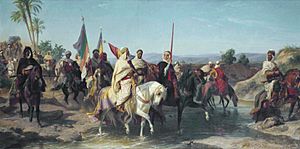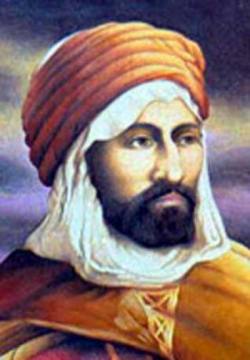Algerian popular resistance against French invasion facts for kids
Quick facts for kids Algerian popular resistance against French invasion |
|||||
|---|---|---|---|---|---|
| Part of the French conquest of Algeria | |||||
 |
|||||
|
|||||
| Belligerents | |||||
| Various groups | |||||
The Algerian popular resistance against French invasion describes how people in Algeria fought back against the French takeover. This resistance began when France invaded Algiers in 1830 and continued until 1903.
Contents
Early Conflicts with France
French-Algerian War (1681-1688)
Before the main invasion, France and Algeria had conflicts. The French-Algerian War (1681-1688) was part of France's efforts against Barbary Pirates.
Fighting Back Against French Rule
The French took over Algeria between 1830 and 1903. In 1827, an argument between Hussein Dey, Algeria's ruler, and the French consul grew serious. This led to a naval blockade. France then invaded and quickly captured Algiers in 1830. They also took other towns along the coast.
Despite problems back home, France decided to keep control of Algeria. More soldiers were sent over the years to stop resistance inside the country.
Mitidja Resistance: The First Fight
When Algiers fell to the French army on June 7, 1830, a new time in Algerian history began. This was the start of French colonial rule.
The fall of the old government left a power gap. New leaders, both political and military, appeared in the countryside. They took on the job of fighting the French.
The Mitidja is a large flat area around Algiers. Controlling this area was key for the French to move further into Algeria. The Mitidja resistance was the first armed uprising by Algerians. It spread across the country and lasted until the early 1900s.
Emir Abdelkader's Leadership
Emir Abdelkader was a strong leader for Algerian resistance. He was deeply religious and believed in fighting for his faith. He soon became known as Amir al-Mu'minin (Commander of the Believers).
Abdelkader first took over from his father. His father was leading the fight against French troops in the Oran province. In 1834, Abdelkader signed the Desmichels Treaty with the French. This treaty recognized Abdelkader's rule over the Oran province in northwest Algeria.
This gave Abdelkader a strong base to expand his power. He created his own state, opposing French rule. He was the sole leader and built an army of about 2,000 men.
Abdelkader wanted to resist French control in other areas, like Algiers. But the French did not want to give up. Abdelkader saw their actions as a reason for war. In July 1839, he gathered leaders from different groups. He declared a conditional holy war (jihad). He traveled the country, asking for money, men, and weapons. By late 1839, he officially declared jihad. An eight-year war followed.
Between 1832 and 1839, Abdelkader successfully built a state. At its largest, it covered almost two-thirds of Algeria. He limited French control to three coastal regions important to both sides.
Ahmed Bey's Stand in the East
Ahmed Bey was the last ruler of Constantine. He led the Algerian resistance in eastern Algeria. He had help from Hussein Pasha. As a leader, he modernized his army. This helped him defend Constantine bravely against the French.
In 1837, the French attacked Constantine. Ahmed Bey was forced to flee to the Aurès Mountains. He continued to lead the resistance from there. He was captured by the French in 1848.
Mokrani Kabyle Uprising
The Kabylia region was always very independent. Its people kept their own ways even under Ottoman rule. But by 1830, the French had moved into the region. They faced strong resistance from the locals.
Life in Kabylia became very hard. There was famine, and the French tried to turn different groups against each other. This led to many uprisings. The unrest continued, leading to the Mokrani Revolt in 1871.
Cheikh Mokrani, a Kabyle leader, led this revolt. It started when a Spahi (an Algerian cavalry soldier working for the French) refused to go fight in France in 1871. Mokrani also wanted his people to be free from French rule. He gathered a war council. The revolt began in April 1871. About 150,000 Kabyles joined the fight. This was a big threat to the French. The revolt ended in June 1872. Boumezrag, who was leading the revolt by then, was captured by the French. This rebellion spread across much of Algeria. It was the last major revolt before the War of Liberation, which led to independence.
Algerian Resistance During French Rule
French Algeria refers to the time when France ruled Algeria. This began with the invasion of Algiers in 1830. It lasted until the Algerian War of Independence ended in 1962. For 132 years, Algeria was under French control. The coastal area, where most people lived, was even considered part of France from 1848 until independence.
Everyday Nonviolent Resistance (1830s-1950s)
People in Algeria also resisted French rule in nonviolent ways every day. After the French invasion in 1830, many Algerians moved to other Muslim countries. This migration was seen as a way to resist non-Muslim rule. Later, it was also a way to avoid being forced into the military.
People also refused to join French social programs. They would not send their children to French schools. Boycotts were another way people showed their opposition.
Algerian culture was suppressed in public. So, homes and religious sites became places of resistance. Here, people protected and strengthened their cultural identity and practices.
Rise of Algerian Nationalism
Algerian nationalism grew from the differences between Algerians and the French. It was about the tensions between French and Algerian languages and cultures. Leaders like Ben Badis and Djamila Bouhired inspired many. They were among the many who opposed French colonial rule.
Movement for Democratic Liberties
The Algerian People's Party (PPA) was banned after the Sétif protests. So, the Movement for the Triumph of Democratic Liberties (MTDL) was formed in October 1946 to replace it. Messali Hadj still led this new nationalist party. He first called for people to boycott elections.
However, after Messali Hadj was released from prison in 1946, MTDL candidates ran in elections. They won a third of the seats for Muslim Algerians in the new French National Assembly.
Some nationalists criticized this move. In 1947, a secret military group was formed alongside the MTDL. This was the Special Organisation (OS). Its goal was to fight for independence. But problems and disagreements grew within the movement. Many young people joined the OS to fight colonialism. At the same time, some members started to question Messali's leadership.
This led to a split in 1953. One group, the "Centralists," pushed for revolution. The other, Messalists, did not want to start an armed fight right away.
The Special Organisation
After the Sétif massacre, many Algerians realized peaceful change was impossible. Self-determination became the main goal for Algerian nationalists. Many called for armed conflict with the French. They saw guerrilla warfare as necessary to win independence.
The MTDL leaders agreed to create the Special Organisation (OS). It was a secret military group. Mohamed Belouizdad of the MTDL founded it in 1947. In the years that followed, they prepared for an armed uprising against France. They carried out armed attacks, like the one on the Oran Post Office in 1949, to get money for their operations.
National Liberation Front (FLN)
Messali lost his main role as an Algerian nationalist leader. Tensions grew in the MTDL. So, the "Centralists" group formed the Revolutionary Committee of Unity and Action (CRUA). This movement then became the National Liberation Front (FLN). The FLN started the War of Independence in 1954.
The Algerian Revolution
The Algerian War was fought between France and the Algerian National Liberation Front. It lasted from 1954 to 1962. This war led to Algeria winning its independence from France. It was an important decolonization war. It involved guerrilla warfare and was a complex conflict.
Women's Role in Resistance
About 11,000 Algerian women took part in the Algerian War. Many joined the FNL.
During the Battle of Algiers (1956-1957), women played a special role. They would dress like Europeans and place bombs in places where Europeans gathered. One famous woman was Djamila Bouhired (born 1935). She became a symbol of Algeria's fight for freedom after she was arrested.
See also
- History of Algeria
- Deylik of Algeria
- Mitidja resistance
- Emir Abdelkader resistance
- Kabylia resistance
- French Algeria
- Declaration of 1 November 1954
- Algerian War




